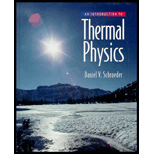Solutions for An Introduction to Thermal Physics
Problem 41P:
To measure the heat capacity of an object, all you usually have to do is put it in thermal contact...Problem 42P:
The specific heat capacity of Albertsons Rotini Tricolore is approximately 1.8J/gC. Suppose you toss...Problem 43P:
Calculate the heat capacity of liquid water per molecule, in terms of k. Suppose (incorrectly) that...Problem 46P:
Measured heat capacities of solids and liquids are almost always at constant pressure, not constant...Problem 47P:
Your 200-g cup of tea is boiling-hot. About how much ice should you add to bring it down to a...Problem 48P:
When spring finally arrives in the mountains, the snow pack may be two meters deep, composed of 50...Problem 50P:
Consider the combustion of one mole of methane gas: CH4(gas)+2O2(gas)CO2(gas)+2H2O(gas). The system...Problem 51P:
Use the data at the back of this book to determine H for the combustion of a mole of glucose,...Problem 52P:
The enthalpy of combustion of a gallon (3.8 liters) of gasoline is about 31,000 kcal. The enthalpy...Browse All Chapters of This Textbook
Chapter 1.1 - Thermal EquilibriumChapter 1.2 - The Ideal GasChapter 1.3 - Equipartition Of EnergyChapter 1.4 - Heat And WorkChapter 1.5 - Compression WorkChapter 1.6 - Heat CapacitiesChapter 1.7 - Rates Of ProcessesChapter 2.1 - Two-state SystemsChapter 2.2 - The Einstein Model Of A SolidChapter 2.3 - Interacting Systems
Chapter 2.4 - Large SystemsChapter 2.5 - The Ideal GasChapter 2.6 - EntropyChapter 3.1 - TemperatureChapter 3.2 - Entropy And HeatChapter 3.3 - ParamagnetismChapter 3.4 - Mechanical Equilibrium And PressureChapter 3.5 - Diffusive Equilibrium And Chemical PotentialChapter 3.6 - Summary And A Look AheadChapter 4.1 - Heat EnginesChapter 4.2 - RefrigeratorsChapter 4.3 - Real Heat EnginesChapter 4.4 - Real RefrigeratorsChapter 5.1 - Free Energy As Available WorkChapter 5.2 - Free Energy As A Force Toward EquilibriumChapter 5.3 - Phase Transformations Of Pure SubstancesChapter 5.4 - Phase Tranformations Of MixturesChapter 5.5 - Dilute SolutionsChapter 5.6 - Chemical EquilibriumChapter 6.1 - The Boltzmann FactorChapter 6.2 - Average ValuesChapter 6.3 - The Equipartition TheoremChapter 6.4 - The Maxwell Speed DistributionChapter 6.5 - Partition Functions And Free EnergyChapter 6.6 - Partition Functions For Composite SystemsChapter 6.7 - Ideal Gas RevisitedChapter 7.1 - The Gibbs FactorChapter 7.2 - Bosons And FermionsChapter 7.3 - Degenerate Fermi GasesChapter 7.4 - Blackbody RadiationChapter 7.5 - Debye Theory Of SolidsChapter 7.6 - Bose-einstein CondensationChapter 8.1 - Weakly Interacting GasesChapter 8.2 - The Ising Model Of A FerromagnetChapter A.1 - Evidence For Wave-particle DualityChapter A.2 - WavefunctionsChapter A.3 - Definite-energy WavefunctionsChapter A.4 - Angular MomentumChapter A.6 - Quantum Field TheoryChapter B.1 - Gaussian IntegralsChapter B.2 - The Gamma FunctionChapter B.3 - Stirling's ApproximationChapter B.4 - Area Of A D-dimensional HypersphereChapter B.5 - Integrals Of Quantum Statistics
Book Details
I. FUNDAMENTALS.
1. Energy in Thermal Physics.
2. The Second Law.
3. Interactions and Implications.
II. THERMODYNAMICS.
4. Engines and Refrigerators.
5. Free Energy and Chemical Thermodynamics.
III. STATISTICAL MECHANICS.
6. Boltzmann Statistics.
7. Quantum Statistics.
8. Systems of Interacting Particles.
Appendix A. Elements of Quantum Mechanics.
Appendix B. Mathematical Results.
Reference Data.
Suggested Reading.
Sample Solutions for this Textbook
We offer sample solutions for An Introduction to Thermal Physics homework problems. See examples below:
Chapter 1.7, Problem 56PChapter 2.6, Problem 28PGiven: The entropy of an ideal gas is, S=Nk[ln(2πmAU ( Nh ) 2)+2] Calculation: To get the...Chapter 4.4, Problem 29PGiven: The chemical reactions are 2H ↔ H2 ……. (1) 2CO + O2 ↔ 2CO2 …… (2) CH4 + 2O2 ↔ 2 H2O + CO2 ……....Given: The equilibrium temperature of an ideal gas is T . Formula used: Write the expression for the...Given: The given integral is ∫0∞xex−1dx . Formula used: Write the value of standard integral....Chapter 8.2, Problem 15PFormula used: Total energy within the box can be written as: E=2∑ n x ∑ n y ∑ n z ε( n → ) =2∭ε( n →...
More Editions of This Book
Corresponding editions of this textbook are also available below:
An Introduction To Thermal Physics
1st Edition
ISBN: 9789332535077
Related Physics Textbooks with Solutions
Still sussing out bartleby
Check out a sample textbook solution.
